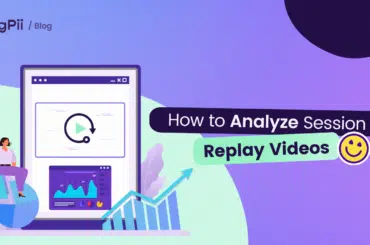Session replay is a tool that records and replays visitor interactions with your website. It captures every click, mouse movement, and scroll, providing a comprehensive visual record of the user experience.
Imagine if you could go back in time and watch how every user that visited your website navigated the site, the elements they interacted with, how long they stayed on a page, how far down they scrolled, and whether or not they took a particular action you expected them to take.
That would be great, right?
By the time you return to the present, you’ll have enough information about the problems users face while using your website.
This article discusses this digital superpower, which you are most likely familiar with as Session Replay.
What is Session Replay?
A session replay is a visual compilation of your site’s visitors’ journey during a session on your website.
It includes all their activities and interactions, such as clicks, scrolls, form fills, and other interactions with different elements of your site.

How do you record all these? With a session replay tool.
A session replay tool is a web analytics and user experience visualization tool that allows you to record and watch user sessions on your website to help you understand their behavior and learn about their challenges.
With a session replay tool, you can rewind, fast-forward, and pause recorded sessions to understand how users interact with your digital products fully.
Why should you even bother with session replay at all?
If you own an ecommerce website, you are most likely using a lot of analytical tools to understand your customers better and see how you can leverage this knowledge to service them better, right?
While these other analytics tools are focused on providing quantitative data and answering questions such as “how many” or “how much,” session replay will show you the “why” behind these figures.
For example, your typical analytics tool can reveal that the click-through rate on a button on your site is below average, and a session replay tool will show you why the click-through rate is below average.
Businesses often use session replay to reveal user frustrations and other usability issues. Insights from these sessions are then used to improve the overall user experience on the site.
A session replay has the significant advantage of showing how customers interact with your site over other analytics software.
How Does Session Replay Work?
So, how exactly does a session replay work?
Imagine being able to step back in time and see through the eyes of a visitor to your website, watching every move, hesitation, and click.
This is essentially what session replay technology allows us to do. It’s like having a digital over-the-shoulder view of each user interaction, providing a comprehensive and accurate playback of their experience.
Data Collection: The journey begins when a user lands on your site. From that moment, session replay tools quietly work in the background, meticulously recording every interaction.
Each action is captured in real-time, whether the user is typing, clicking, scrolling, or navigating across different pages. The system ensures this process is invisible to the user to maintain a smooth and uninterrupted experience.
Data Storage: Once captured, the data isn’t just a jumble of clicks and keystrokes. It’s a structured narrative of the user’s journey, storing details like HTML changes and the timing of each action. This data is securely saved on servers and ready to be revisited when needed.
Reconstruction: To replay a session, the software reconstructs the recorded data, stitching together each action in the sequence in which it occurred. This precise reconstruction ensures that what you see accurately represents the user’s session, with every detail preserved.
Visualization: Now comes the playback. The session is visualized to closely mirror the user’s original experience. You can watch a complete replay that maps out the entire journey from start to finish, revealing not just what users did but also potential points where they may have struggled or hesitated.
Analysis: With the replay available, the final step is analysis. This phase turns observations into insights. Teams across the business, from UX designers to marketing professionals, delve into these replays to extract valuable information. They look for trends, identify common issues, and seek opportunities to enhance the site’s design and functionality.
This is how a typical session replay works. You can see how the user navigates the website and interacts with different elements.
Benefits of Session Replay
Session replay is not just a tool; it’s a transformative asset for businesses looking to understand and enhance user experiences on their digital platforms.
Here’s how it delivers value:
1. Enhanced User Experience
By watching real user interactions, teams can pinpoint exactly where users face difficulties, whether it’s filling out forms, navigating through menus, or processing payments.
Understanding these pain points allows for direct improvements in website usability, ultimately enhancing the overall user experience.
2. Session Replay can help improve Conversion Rates
Every business aims to convert visitors into customers, and session replays are instrumental in identifying obstacles on this path.
Whether it’s an unresponsive call-to-action button or a complicated checkout process, understanding these barriers through session replays can lead to targeted changes that boost conversion rates.
3. Faster Problem Resolution
With session replay, identifying and resolving website issues becomes much more straightforward. Developers and designers can see bugs in action and understand their context, which reduces the time spent replicating and fixing issues, enhancing productivity and site performance.
4. Better Customer Support
Customer support teams can utilize session replays to view the customer’s last interactions before they report a problem.
This insight allows support staff to provide quicker and more accurate assistance, significantly improving customer service and satisfaction.
5. Informed Decision Making
Session replays provide a wealth of qualitative data that offers a comprehensive view of user behavior when combined with quantitative analytics.
This dual layer of insight ensures that business decisions are data-driven and focused on actual user needs and behaviors, leading to more effective strategy adjustments.
6. Session replay helps with training and quality assurance
Replays can be used to train new staff by showing them real user interactions and common issues they might encounter. They’re also a tool for ongoing quality assurance, helping ensure that all elements of the website function as intended after updates or changes.
Use Cases of Session Replay
Session replay tools offer a wide array of practical applications across different business functions. Here are some key use cases that illustrate how these tools can be leveraged to enhance user experience, optimize conversion rates, and more:
1. UX/UI Optimization
One of the primary uses of session replay is in UX/UI design. By observing how real users interact with a website or application, designers can identify and address usability issues.
This includes spotting areas where users struggle, such as confusing navigation or poorly placed call-to-action buttons. This allows for targeted design improvements that enhance user engagement and satisfaction.
2. Conversion Rate Optimization (CRO)
Session replays are invaluable for identifying the barriers that prevent users from completing a conversion. Whether it’s a cumbersome checkout process or a long sign-up form, understanding these pain points allows marketers to make data-driven adjustments that smooth the user journey and increase conversion rates.
3. Customer Support and Troubleshooting
When customers encounter problems, session replay can help support teams see exactly what went wrong. Instead of relying solely on user descriptions, support agents can review a replay of the user’s session to quickly understand the issue. This leads to faster resolution times, a reduction in back-and-forth communication, and a more satisfying customer support experience.
4. Bug Identification and Resolution
For development teams, session replays can act as a powerful diagnostic tool. Watching a user encounter a bug in real-time, can help developers can see first-hand what went wrong, under what conditions, and how the issue impacts the user experience. This direct insight speeds up the debugging process and helps ensure more robust solutions.
5. Compliance and Legal Documentation
In industries where compliance with regulations is crucial, session replays can provide necessary documentation of user interactions.
For example, in finance or healthcare, replays can show that all protocols were followed during user interactions, serving as evidence in the case of audits or disputes.
6. Training and Onboarding
Session replays can also be used for internal training purposes. New employees can watch real user interactions to gain a better understanding of common customer challenges and the typical user flow. This practical exposure can help them learn faster and perform better in their roles.
How do you Analyze Session Replay?
Analyzing a session replay effectively can seem daunting at first, but with a clear, methodical approach, you can unlock invaluable insights into user behavior and website performance.
Here’s a practical guide to help you make the most of your session replay analysis:
Step 1: Define Your Objectives
Before diving into any session replays, knowing what you’re looking for is important. Are you trying to understand why users abandon their carts at a specific point? Or perhaps you want to see how users interact with a new feature?
Setting clear objectives will guide your focus and ensure you’re not just watching replays without purpose.
Step 2: Select Relevant Sessions
With your objectives in mind, choose sessions that are likely to yield the most relevant information. If you’re investigating a specific issue, like a drop in conversion rates on a landing page, filter sessions that include visits to that page. Use criteria such as user demographics, behavior patterns, and entry points to refine your selection.
Step 3: Watch and Take Notes
As you watch the sessions, keep detailed notes on user actions, especially those that align with your objectives.
Pay attention to points where users hesitate, exhibit confusion, or abandon the process altogether. Note any technical glitches they encounter as well.
These observations will form the basis of your analysis.
Step 4: Identify Patterns and Anomalies
After reviewing several sessions, start to look for patterns or recurring issues. Do multiple users fail to notice your call-to-action button? Do they all scroll past important content? Identifying these patterns will help pinpoint areas of your website that need improvement.
Step 5: Collaborate and Discuss Findings
Bring your findings to your team, especially those involved in UX design, development, and product management. Discussing these insights can provide additional perspectives and help validate your observations. This collaboration is necessary to develop a comprehensive understanding of the issues and plan effective solutions.
Step 6: Prioritize Fixes and Enhancements
Based on your analysis and team input, prioritize the changes that need to be made. Consider the potential improvements’ impact and the resources required to implement them. Start with modifications that will have the most significant benefit to user experience and business outcomes.
Step 7: Implement Changes and Monitor Results
Make the necessary changes to your website, and closely monitor how these adjustments affect user behavior.
Use both quantitative data (like conversion rates) and further session replays to assess the effectiveness of your interventions.
This monitoring will tell you if your changes are working or if further tweaks are needed.
Step 8: Repeat the Process
User behavior and website dynamics are always evolving, so treat session replay analysis as an ongoing task.
Regular reviews will help you keep up with changes in user expectations and technological advancements, ensuring your website remains user-friendly and competitive.
Integrating Session Replay with Analytics
Analytics tools are excellent for gathering quantitative data and answering questions about how many and how much, but never the question “why.” Some web data analytics tools focus on numerical data, as they only provide numbers.
Session replays focus on understanding user behavior while interacting with your site and help you understand why they do what they do.
Integrating session replay tools, which provide user behavior analytics with other web analytics tools, can give more meaning to the overall insights you gather on your website.
For example, your analytics tool shows you how many users click on a button or interact with an element on your website. Your session replay shows how and why the users click or do not click on the button.
Data analytics and insights show that there’s a problem, but session replay helps you understand how to fix it.
Things to look out for in a Session Replay Tool
Choosing a session replay tool can be challenging, considering that there are many tools out there, most offering similar features. It’s important to choose wisely.
To help you make the best choice, here are some essential factors to consider when choosing a session replay tool.
-
Accuracy of Replays
The tool should accurately represent the user’s session. This includes correct rendering of CSS, JavaScript interactions, and dynamic content, ensuring you see exactly what the user experienced.
-
Ease of Integration
Consider how easily the tool integrates with your current tech stack. It should seamlessly work with your website’s technology and other analytics or testing tools without causing disruptions or slowing down your site.
-
User Segmentation and Filtering
It is important to filter and segment replays based on specific criteria such as user behavior, traffic sources, device type, or geographical location. This helps you focus your analysis on specific user groups or issues.
-
Event Tagging and Annotations
Even though most session replay tools boast that they have little to no impact on your site’s performance, that is not entirely true. The technology behind the tool and the one your site runs on will determine the level of impact. So, you only want to choose a tool that does not have too much impact on your site.
-
Performance Metrics
Besides visual replay, the tool should provide performance metrics like load times, interaction times, and error occurrences. These metrics are vital for understanding the context around user behavior and technical issues.
-
Performance Metrics
Besides visual replay, the tool should provide performance metrics like load times, interaction times, and error occurrences. These metrics are vital for understanding the context around user behavior and technical issues.
6. Data Privacy and Security
Ensuring compliance with data protection regulations (like GDPR) is critical. The tool should offer options to mask sensitive data and robust security practices to protect user data.
7. Scalability and Reliability
The tool should handle large volumes of data and traffic without performance issues. It should also reliably store and manage data, ensuring that replays are always available when needed.
8. Customer Support and Resources
Good customer support and comprehensive resources such as tutorials, guides, and community forums are invaluable. These can help you maximize the tool’s potential and troubleshoot any issues.
9. Advanced Analytical Tools
Look for features like heatmaps or integration with conversion rate optimization tools. These can complement the qualitative data from session replays with quantitative insights, giving you a fuller picture of user experience.
10. Cost -Effectiveness
Finally, consider the pricing structure of the tool. It should align with your budget and the scale of your operations, offering a good balance between cost and the features provided.



